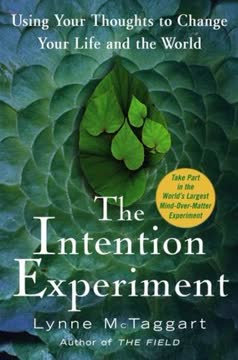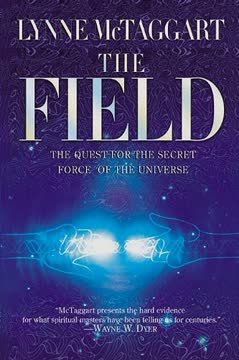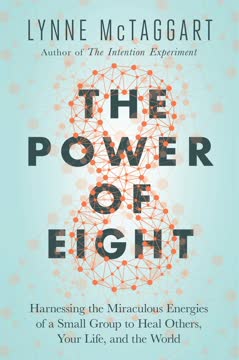Key Takeaways
1. The Universe is Interconnected and Mutable
The existence of the Field implies that all matter in the universe is connected on the subatomic level through a constant dance of quantum energy exchange.
Quantum reality. Contrary to classical physics, the universe is not a collection of separate, fixed objects. Frontier scientists have shown that at the subatomic level, all matter is interconnected through a vast energy sea called the Zero Point Field. This constant exchange of quantum energy means that everything influences everything else.
Mutable matter. Experiments, like those by Tom Rosenbaum and Sayantani Ghosh, demonstrated that even macroscopic matter, such as a tiny salt crystal, exhibits quantum entanglement. Its atoms can align and behave as one giant atom, overriding external influences like temperature or magnetic fields. This suggests that physical matter is not solid and stable, but fluid and open to influence.
Observer effect. The act of observation plays a central role in shaping reality. Quantum physics reveals that subatomic particles exist as "clouds of probability" until observed, at which point they "collapse" into a particular state. This implies that consciousness is not merely a passive observer but an active participant in creating and influencing the physical world around us.
2. Humans are Coherent Energy Transmitters
Every thought we have is a tangible energy with the power to transform.
Human antenna. Pioneering research by Gary Schwartz revealed that the human body acts as both a receiver and a transmitter of invisible information. Simple movements generate electrical charges, and focused thoughts create measurable energy fields. This suggests that our thoughts are not confined to our brains but are constantly radiating outward.
Coherent light. Fritz-Albert Popp's discovery of biophotons—tiny particles of light emitted by all living things—provides a mechanism for this transmission. These biophotons are highly coherent, meaning they act like a single, superpowerful frequency, similar to a laser. Healing intention, for example, manifests as organized waves of light, capable of influencing other living systems.
Energy manifestation. Experiments by William Tiller showed that directed thoughts produce demonstrable physical energy, even over remote distances. This energy can alter the molecular structure of water and other substances. Our intentions, therefore, are not just abstract mental processes but tangible forces that can reshape physical reality.
3. Life Forms are in Constant Communication
Somehow, a constant stream of messages was being sent out, received, and replied to.
Primary perception. Cleve Backster's controversial but compelling experiments with plants demonstrated their ability to react to human thoughts and emotions, even at a distance. This "primary perception" suggests that all life forms, from bacteria to humans, are exquisitely attuned to their environment and constantly exchange telepathic information.
Biophoton signaling. Fritz-Albert Popp's work with biophotons further elucidated this communication. He found that organisms absorb and emit light, coordinating with their neighbors and even other species. This light acts as a sophisticated communication system, allowing living things to register and respond to subtle changes in their surroundings, including human intentions.
Environmental attunement. Konstantin Korotkov's Gas Discharge Visualization (GDV) technique visually confirmed that human emotions and intentions profoundly affect the energy fields of others and even plants. Negative thoughts diminish an organism's energy field, while positive thoughts enhance it. This constant two-way flow of information means every thought we have impacts the light and well-being of life around us.
4. Intention Synchronizes and Attunes Bodies
When you send an intention, every major physiological system in your body is mirrored in the body of the receiver.
Physiological mirroring. Studies on Direct Mental Interaction with Living Systems (DMILS) show that when one person sends focused intention to another, their physiological systems can become synchronized. This mirroring effect has been observed in brain waves, heart rate, skin conductance, and even gut activity, suggesting a deep, unconscious connection.
Entrainment phenomenon. This synchronization is akin to "entrainment," where two oscillating systems fall into rhythm. For instance, a sender's brain waves or heart rhythms can entrain those of a distant receiver. This implies that intention is a powerful form of energetic attunement, allowing one person's coherent energy to influence and "reorder" another's.
Anticipatory responses. Research by Dean Radin and Rollin McCraty revealed that recipients can unconsciously anticipate incoming intentions or future events. The heart, in particular, appears to receive intuitive information moments before the brain, suggesting it acts as a primary "antenna" for nonlocal information. This highlights the body's innate capacity to perceive beyond conventional senses.
5. Mastering Intention Requires Inner Transformation
The monks had conditioned their brains to tune in to happiness most of the time.
Brain plasticity. Intensive meditation, as studied by Herbert Benson and Richard Davidson, demonstrates that sustained focused attention can permanently alter brain physiology. Monks, through years of practice, exhibit heightened gamma-band activity—a state of peak intensity and heightened awareness—and increased cortical thickness in attention-related brain regions. This shows the brain is plastic and can be remodeled by conscious thought.
Ego surrender. Successful healers and "master" intenders consistently describe the importance of surrendering their ego and sense of individual self. They visualize merging with the person to be healed and with a greater, universal force. This "channeling" approach, where the individual becomes a conduit rather than the source of power, appears to be crucial for potent transmission.
Thin boundaries. Psychological research suggests that individuals with "thin boundaries"—those who are open, unguarded, and easily merge with others' identities—are more adept at remote influence. This capacity for profound dissociation and absorption allows them to access a state of joint consciousness, where an impersonal self can facilitate healing or influence.
6. Context and Belief Amplify Intention
The best outcomes were among those who had received Johrei and believed they had received it.
Specificity and connection. Large-scale prayer studies often failed due to a lack of specific intention and a personal connection between the pray-ers and the recipients. In contrast, successful healing studies, like Elisabeth Targ's AIDS research, provided healers with detailed patient information, fostering a meaningful bond and a clear, targeted intention.
Healer's well-being. Gary Schwartz's experiments with Reiki and Johrei practitioners revealed that a healer's own emotional and physical well-being significantly impacts the outcome. Healers who felt well had a beneficial effect, while those feeling unwell sometimes had a deleterious one. This suggests that the sender's internal state is a critical factor in the efficacy of intention.
Shared belief. The placebo effect powerfully demonstrates that belief in a treatment can create real physiological changes. Schwartz's studies further showed that patients who believed they were receiving healing experienced better outcomes, regardless of whether they actually received it. A shared belief system between sender and receiver, along with a positive emotional state, appears to amplify the power of intention.
7. Timing and Location Matter for Potent Effects
To send intention effectively, we would have to take account of these energies.
Geomagnetic influence. Michael Persinger's extensive research revealed that Earth's geomagnetic fields (GMFs), influenced by solar activity, profoundly affect human biology, particularly the heart and brain. While telepathy and ESP are enhanced during geomagnetic calm, psychokinesis (mind-over-matter intention) appears to increase when the Earth's energy is agitated.
Optimal timing. For effective intention, it's beneficial to align with periods of increased geomagnetic activity. Checking space weather forecasts (e.g., NOAA's Space Environment Center) for a K index of 5 or more, or an A index over 200, can optimize transmission. Additionally, specific times like 1:00 P.M. local sidereal time have shown enhanced psychokinetic effects.
Conditioned spaces. William Tiller's "black box" experiments demonstrated that human intention can "condition" a physical space. Labs where intentions were repeatedly sent began to manifest rhythmic fluctuations in temperature and pH, suggesting a higher state of coherence in the Zero Point Field. This "charged" environment can then amplify subsequent intentions, creating a lasting positive effect.
8. Thoughts are Mental Blueprints for Reality
The brain sent the same instructions to the body, whether the skiers were simply thinking of a particular movement or actually carrying it out.
Mental rehearsal. Elite athletes routinely use "mental rehearsal" to enhance performance. By vividly imagining every detail of a desired outcome from their own perspective, engaging all five senses, they train their brains to execute complex movements flawlessly. This practice lays down neural pathways, making physical execution easier and more precise.
Brain-body connection. Electromyography (EMG) and electroencephalography (EEG) studies show that the brain does not distinguish between a thought and an action. The same electrical impulses and neural patterns are activated whether a movement is imagined or physically performed. This means that simply thinking about an action can prime the body to carry it out, even increasing muscle strength without physical exercise.
Placebo power. The profound impact of the placebo effect underscores the body's responsiveness to mental instructions. Belief in a treatment, even a sugar pill, can trigger the body's self-healing mechanisms, releasing neurochemicals like dopamine and altering physiological processes. This highlights that our conscious intentions and expectations can directly influence our physical health and well-being.
9. Negative Intentions are Also Powerful
In both experiments, negative intention was more powerful than positive intention.
Harmful thoughts. Disturbingly, scientific studies suggest that negative intentions can be as, or even more, powerful than positive ones. Experiments by Dick Blasband and Jean Barry showed that intentions to stunt growth or inhibit bacterial mutation had measurable, deleterious effects on living organisms. This implies that our negative thoughts, conscious or unconscious, can also manifest physically.
Unintended consequences. The "gremlin effect," where individuals inadvertently cause electronic equipment to malfunction, hints at the pervasive influence of unconscious negative states. Similarly, studies suggest that negative emotions or unresolved conflicts within relationships can physically impede healing processes, such as wound repair.
Protection and redirection. While negative intentions can be potent, some research suggests that consciously framing intentions as a request for "natural order" rather than destruction can be more effective for healing. Additionally, practices like John Diamond's "homing thought"—focusing on one's ultimate purpose—are proposed as ways to ground oneself against unwelcome influences.
10. Time is Fluid; Past, Present, and Future are Interconnected
The very act of measuring Alice at a later time influenced and indeed changed how it was polarized earlier.
Retrocausation. Groundbreaking studies, like Leonard Leibovici's "retroactive prayer" and Helmut Schmidt's time-displaced REG experiments, suggest that intention can influence events that have already occurred. This challenges the conventional linear view of time, implying that our present thoughts can reach back to affect past outcomes.
Non-linear reality. Physics theories, including those involving scalar waves and the observer effect, propose that at the quantum level, time and space are not absolute but exist as a "smeared-out present." This means that all information in the universe is potentially accessible at any moment, and our consciousness plays a role in "collapsing" potential realities into existence, regardless of conventional time sequence.
Future influencing past. The concept of "time-reversed interference" suggests that future events can influence earlier nervous system responses. This implies that our future choices and possibilities are constantly interacting with and shaping our present actions and decisions. Our intentions, therefore, are not just about creating a future, but also about influencing the very fabric of our past.
11. Collective Intention Can Create Global Change
One well-directed thought may be a gentle but effective way for men and women on the street to take matters of global interest into their own hands.
Group consciousness. Research from the Global Consciousness Project demonstrates that intensely felt collective emotions, particularly during major global events like 9/11, correlate with measurable deviations from randomness in REG machines worldwide. This suggests the existence of a "group mind" capable of exerting a psychokinetic effect on physical systems.
Threshold effect. The Transcendental Meditation (TM) organization's "Maharishi Effect" claims that when a critical percentage of a population practices advanced meditation, it can significantly reduce crime rates and conflict. While controversial, these studies suggest a "super radiance" effect, where coherent group consciousness can order disordered frequencies in the environment.
Mass impact. The initial "Intention Experiment" with readers of this book, targeting algae and a human subject in Germany from London, showed a significant decrease in biophoton emissions, similar to the effect of an experienced healer. This pilot study suggests that collective positive thinking, even from a distance, can have a measurable healing effect on living organisms, hinting at the potential to address global challenges like climate change.
Last updated:
FAQ
1. What is The Intention Experiment by Lynne McTaggart about?
- Scientific exploration of intention: The book investigates the scientific evidence that human thoughts and intentions can influence physical reality, including health, the environment, and social conditions.
- Challenging traditional science: It questions the classical Newtonian worldview of isolated objects and linear causality, presenting a quantum perspective of interconnectedness and mutability.
- Living book concept: Readers are invited to participate in ongoing group experiments, making it an interactive, “living” book that blends theory with real-world application.
2. Why should I read The Intention Experiment by Lynne McTaggart?
- Paradigm-shifting perspective: The book offers a groundbreaking view that consciousness and intention are central to creating and influencing reality, potentially revolutionizing our understanding of health, healing, and human potential.
- Empowerment through science: It compiles decades of rigorous research, providing credible evidence that thoughts can influence biological systems, random events, and even past occurrences.
- Practical engagement: Readers are empowered to participate in scientific experiments and learn actionable techniques to harness the power of intention in their own lives.
3. What are the key takeaways from The Intention Experiment by Lynne McTaggart?
- Thoughts shape reality: Consciousness and intention are measurable energies capable of affecting physical matter and biological systems.
- Science meets spirituality: The book bridges quantum physics and consciousness research with spiritual traditions, offering a scientific framework for phenomena once considered paranormal.
- Active participation: Readers are encouraged to engage in intention experiments, using focused attention, mental rehearsal, and group coherence for personal and global transformation.
4. What scientific evidence does Lynne McTaggart present in The Intention Experiment to support the power of intention?
- Quantum physics foundation: Experiments show that subatomic particles exist in states of potential and become definite only upon observation, implying consciousness shapes reality.
- Mind-matter interaction: Research at Princeton’s PEAR lab and other institutions demonstrates that human intention can influence random-event generators, biological systems, and even healing outcomes.
- Biophoton and healing studies: Studies reveal that focused intention can alter biophoton emissions in living organisms and improve health outcomes, with measurable physiological correlates.
5. How does The Intention Experiment by Lynne McTaggart define and explain intention?
- Focused mental energy: Intention is described as a concentrated mental focus combined with a clear, specific desire for a particular outcome, engaging all senses in visualization.
- Force of creation: The book posits that intention is a fundamental energy capable of influencing matter, biological processes, and social phenomena.
- Responsibility of thought: Every thought carries power and responsibility, with negative intentions potentially being more potent than positive ones.
6. What practical methods and advice does The Intention Experiment by Lynne McTaggart offer for using intention effectively?
- Creating an intention space: Choose a quiet, comfortable environment free from distractions and electrical pollution, possibly enhanced with candles or plants.
- Powering up and mindfulness: Enter an alpha brainwave state through slow breathing and meditation, cultivating mindfulness to quiet internal chatter.
- Specificity and visualization: State intentions clearly and positively, using detailed mental imagery and mentally rehearsing the desired outcome as if it is already achieved.
- Compassion and connection: Establish empathetic connection with the target, focusing on universal compassion and merging awareness with the greater field.
7. How does The Intention Experiment by Lynne McTaggart explain the mechanism by which thoughts affect matter?
- Zero Point Field: The book highlights the Zero Point Field, a quantum energy sea connecting all matter, as the medium through which intentions may influence reality.
- Quantum entanglement: Experiments show that particles remain instantaneously connected regardless of distance, suggesting nonlocal effects of intention.
- Coherent biophotons: Human thoughts and intentions manifest as coherent streams of light (biophotons), potentially influencing molecular structures and biological processes.
8. What is the significance of the Acetabularia algae experiment in The Intention Experiment by Lynne McTaggart?
- Model organism choice: Acetabularia, a single-celled algae, was chosen for its simplicity and predictability, allowing clear measurement of intention’s effect on biophoton emissions.
- Remote group intention: A group of meditators in London sent intentions to samples in Germany, resulting in significant decreases in biophoton emissions, indicating improved health or reduced stress.
- Implications for the environment: Since algae are vital to ocean ecosystems and climate regulation, the experiment suggests that collective intention could potentially influence environmental health and combat global warming.
9. How does The Intention Experiment by Lynne McTaggart address the power and risks of negative intention, or "The Voodoo Effect"?
- Potency of negative intention: Research shows that harmful thoughts or intentions can have stronger effects than positive ones, as seen in experiments affecting plant growth and cancer cells.
- Ethical concerns: The book discusses risks of unintended negative effects, such as “spray” effects where negative intention might harm the sender or bystanders.
- Protection strategies: Visualization techniques like mental shields or “bubbles” are suggested, though advanced training may be required for effective protection.
10. What evidence does The Intention Experiment by Lynne McTaggart present about retroactive or time-displaced intention?
- Retroactive prayer studies: Prayers sent years after medical events showed statistically significant improvements in patient outcomes, suggesting intention can affect past events.
- Laboratory retro-PK experiments: Studies demonstrate that mental influence can alter random event generator outputs or biological activity recorded before the intention was sent.
- Quantum explanations: Theories involving nonlinear quantum mechanics and the observer effect propose that consciousness collapses potential states across time, making past, present, and future interconnected.
11. How can readers participate in the group intention experiments described in The Intention Experiment by Lynne McTaggart?
- Joining global experiments: Readers can participate via the book’s website, receiving instructions and schedules aligned with geomagnetic activity for sending focused intentions.
- Structured protocols: Participants use meditation and mindfulness exercises to “power up,” then send clear, specific intentions at designated times, often focusing on measurable outcomes.
- Scientific contribution: Results are collected and analyzed by scientists, with findings published online, allowing readers to contribute to frontier research on consciousness and intention.
12. What role do the heart and brain play in intention according to The Intention Experiment by Lynne McTaggart?
- Heart-brain connection: The heart emits the largest electromagnetic field in the body and often receives intuitive information before the brain, acting as a powerful antenna for intention.
- Brain-wave entrainment: During intention and healing, the brain waves of sender and receiver can synchronize, reflecting a deep physiological connection.
- Emotional states: Positive emotions like compassion and love enhance coherence in heart and brain rhythms, making intention more effective, while negative emotions can hinder outcomes.
Review Summary
The Intention Experiment receives mostly positive reviews for its scientific approach to exploring the power of intention and thought. Readers appreciate the extensive research and experiments presented, though some find the technical details tedious. The book challenges conventional thinking about consciousness and reality, drawing connections between quantum physics and spirituality. Critics argue some conclusions may be questionable. Many readers find the concepts fascinating and potentially life-changing, while others struggle with the dense scientific content. The book's invitation to participate in ongoing experiments intrigues many readers.
Similar Books
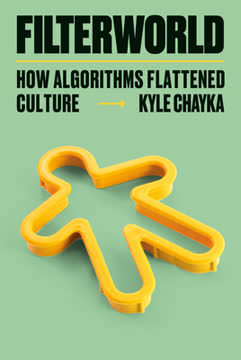
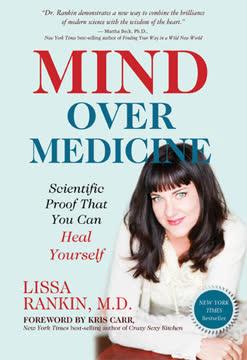
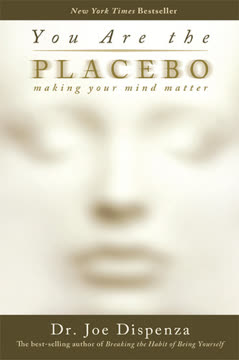
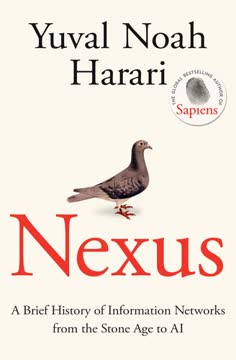
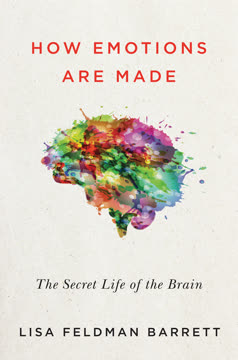

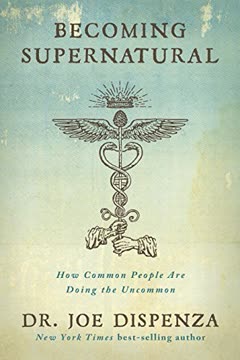

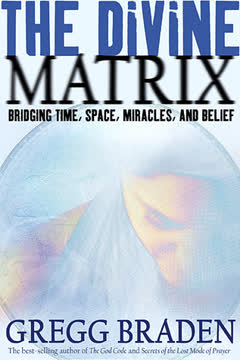
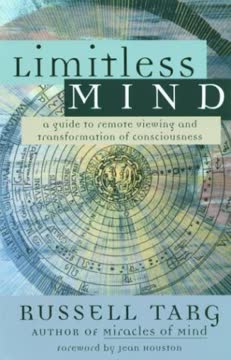
Download PDF
Download EPUB
.epub digital book format is ideal for reading ebooks on phones, tablets, and e-readers.
